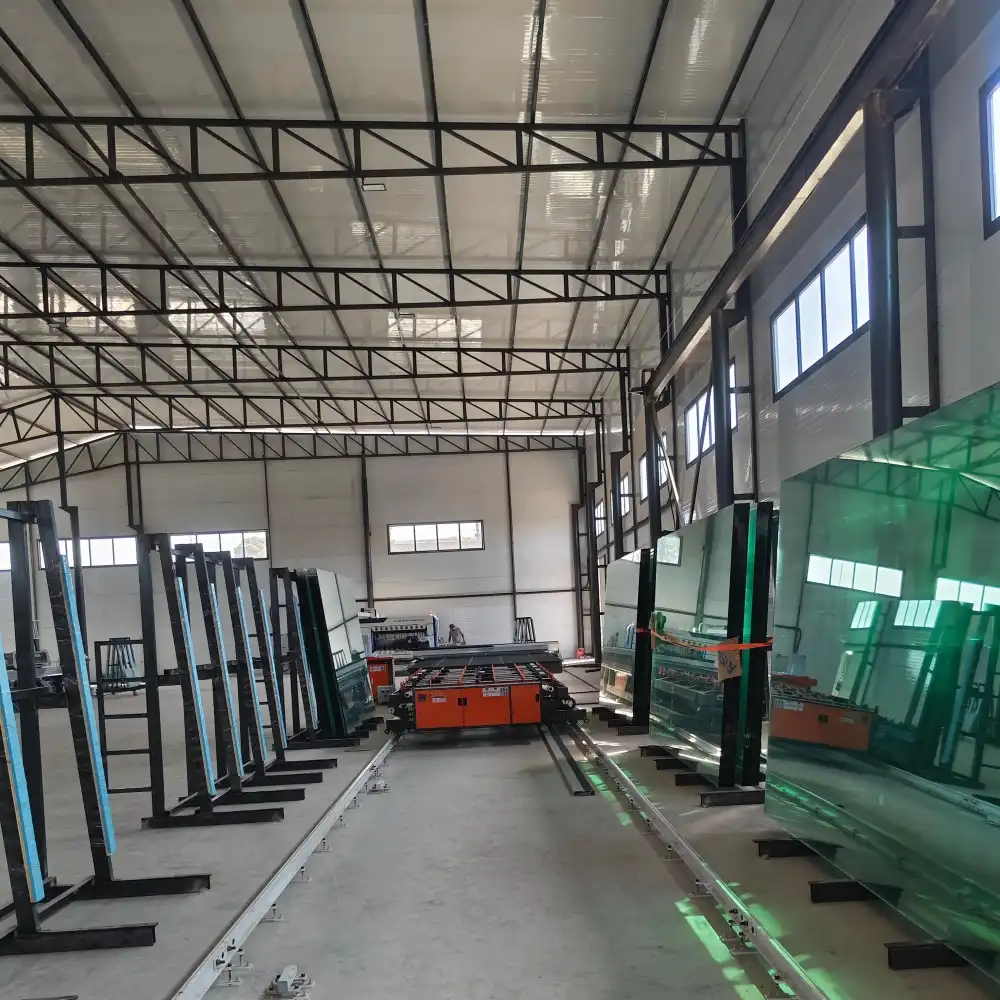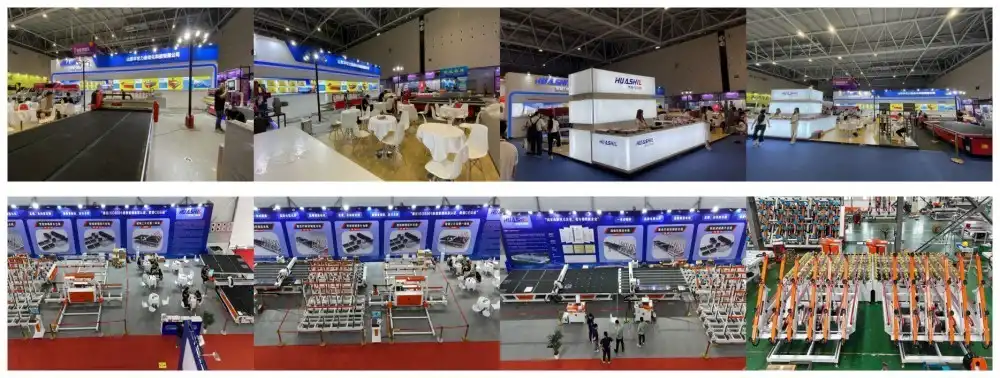In the world of modern glass manufacturing, precision and efficiency are paramount. CNC Glass Loading Cutting Breaking machines have revolutionized the industry, offering unparalleled accuracy and automation in glass processing. These innovative machines have found applications across various sectors, from architectural glazing to automotive manufacturing and furniture production. Let's delve into the fascinating world of CNC glass processing and explore how these machines are shaping the future of glass production.
Architectural Glazing: Producing Windows, Curtain Walls, and Doors
The architectural glass industry has been transformed by the introduction of CNC Glass Loading Cutting Breaking machines. These advanced systems have become indispensable in the production of windows, curtain walls, and doors, offering a level of precision and consistency that was previously unattainable.
One of the primary advantages of using CNC machines in architectural glazing is the ability to handle large glass sheets with ease. These machines can effortlessly process glass panels of various sizes and thicknesses, making them ideal for creating expansive curtain walls and floor-to-ceiling windows that are increasingly popular in modern architecture.
The cutting process is where CNC technology truly shines. Using computer-controlled cutting heads, these machines can execute intricate cuts with micrometer-level accuracy. This precision is crucial when creating custom-shaped windows or doors that need to fit perfectly within a building's design. The ability to program complex cutting patterns also allows for the creation of decorative glass elements, adding aesthetic value to architectural projects.
Moreover, CNC Glass Loading Cutting Breaking machines have significantly improved the efficiency of glass processing for architectural applications. China CNC Glass Loading Cutting Breaking machine suppliers are at the forefront of delivering advanced solutions that combine automation, precision, and reliability to meet the growing demands of the construction and glazing industries. The automated loading and unloading systems minimize human intervention, reducing the risk of damage to the glass and increasing overall productivity. This automation is particularly beneficial when dealing with large volumes of standardized glass panels for commercial building projects.

The breaking function of these machines is equally impressive. After cutting, the glass needs to be separated along the score lines. CNC machines use controlled pressure to break the glass cleanly and precisely, ensuring smooth edges and reducing the need for additional finishing processes. This not only saves time but also enhances the structural integrity of the final product.
In the realm of energy-efficient building design, CNC glass processing plays a crucial role. These machines can handle the cutting and processing of specialized low-emissivity (low-E) glass and other energy-efficient glass types with the same level of precision as standard glass. This capability is essential for meeting stringent building energy codes and contributing to sustainable architecture practices.
How are These Machines Used in Automotive Glass Manufacturing?
The automotive industry relies heavily on CNC Glass Loading Cutting Breaking machines to produce the complex, precision-engineered glass components essential for modern vehicles. From windshields to side windows and rear glasses, these machines ensure that every piece meets the stringent safety and quality standards of the automotive sector.
One of the most challenging aspects of automotive glass production is the creation of windshields. These are not simple flat pieces of glass but rather complex, curved structures designed to enhance aerodynamics and driver visibility while providing crucial structural support to the vehicle. CNC machines excel in cutting the initial flat glass sheets to the precise shape required for each vehicle model. The cutting process must account for the eventual curvature of the windshield, ensuring that after bending and lamination, the final product fits perfectly into the vehicle frame.
Side windows and rear glasses also benefit from CNC precision. These components often have intricate shapes and may include holes for mounting hardware or channels for window regulators. CNC Glass Loading Cutting Breaking machines can create these features with exceptional accuracy, ensuring a perfect fit and smooth operation of the finished windows.
The ability of CNC machines to handle tempered glass is particularly valuable in automotive applications. Tempered glass, which is used for side and rear windows, requires precise cutting before the tempering process. Any imperfections in the cut can lead to weaknesses that may cause the glass to shatter during tempering. The high precision of CNC cutting significantly reduces the risk of such failures, improving production yield and ensuring consistent quality.
Automation in automotive glass production goes beyond just cutting. Many China CNC Glass Loading Cutting Breaking machine suppliers offer integrated systems that can handle the entire process from loading raw glass sheets to cutting, breaking, and even initial edge processing. This level of automation not only increases production speed but also ensures consistency across large production runs – a critical factor in the high-volume world of automotive manufacturing.
Another significant advantage of CNC technology in automotive glass production is its flexibility. As vehicle designs change rapidly, glass shapes and specifications need to evolve as well. CNC machines can be quickly reprogrammed to accommodate new designs, allowing manufacturers to respond swiftly to changes in vehicle models or design updates. This agility is crucial in an industry where time-to-market can make or break a product's success.
The integration of CNC glass processing with other automated systems in automotive production lines has further streamlined manufacturing processes. For instance, data from CAD systems used in vehicle design can be directly translated into cutting instructions for CNC machines, ensuring perfect alignment between the glass components and the vehicle body.
Application in Furniture and Appliance Glass Production
The furniture and appliance industries have embraced CNC Glass Loading Cutting Breaking machines, leveraging their precision and versatility to create innovative and functional glass elements. These machines have opened up new possibilities in design and manufacturing, allowing for the production of complex glass components that enhance both the aesthetics and functionality of furniture and appliances.
In furniture production, glass has become an increasingly popular material for tabletops, shelving units, and decorative panels. CNC machines excel in creating these elements with exacting precision. For instance, a glass tabletop might require not only precise cutting to size but also beveled edges, rounded corners, or even intricate etched patterns. CNC technology can handle all these requirements in a single, automated process, ensuring consistency across production runs and minimizing material waste.
The ability to create custom shapes is particularly valuable in furniture design. CNC Glass Loading Cutting Breaking machines can produce irregularly shaped glass pieces that fit perfectly into designer furniture, such as curved glass doors for cabinets or uniquely shaped glass inserts for coffee tables. This capability allows furniture designers to push the boundaries of their creativity, knowing that their designs can be accurately realized in glass.
In the appliance industry, glass components are crucial for many products, from oven doors to refrigerator shelves and control panels. CNC machines play a vital role in producing these components to exact specifications. For example, the glass used in oven doors must be cut to precise dimensions and often requires holes for handles or vents. The accuracy of CNC cutting ensures that these components fit perfectly and function as intended, which is crucial for the safety and efficiency of the appliance.
The production of glass shelves for refrigerators and display cases also benefits from CNC technology. These shelves often require precise shaping and edge treatments to ensure safety and durability. CNC machines can create rounded edges and corners, reducing the risk of chipping and improving the overall strength of the glass shelf.
One of the most innovative applications of CNC glass processing in the appliance industry is the production of smart appliance interfaces. Many modern appliances feature glass touch panels or displays integrated into their design. CNC machines can cut and process the glass for these interfaces with high precision, including creating openings for displays or touch-sensitive areas. The ability to work with specialized glass types, such as those with embedded conductive coatings for touch sensitivity, makes CNC technology indispensable in this cutting-edge area of appliance design.
The use of CNC technology in furniture and appliance glass production also contributes to sustainability efforts. The precision cutting and efficient material usage enabled by these machines result in less waste compared to traditional glass cutting methods. Additionally, the ability to create perfectly fitted components reduces the need for excessive packaging or protective materials during shipping, further minimizing environmental impact.
As the trend towards smart homes and Internet of Things (IoT) devices continues to grow, the role of CNC glass processing in furniture and appliance production is likely to expand. We may see an increase in furniture pieces with integrated displays or smart surfaces, all requiring the precision and versatility that CNC Glass Loading Cutting Breaking machines provide.

Conclusion
The applications of CNC Glass Loading Cutting Breaking machines across architectural glazing, automotive manufacturing, and furniture and appliance production demonstrate the versatility and indispensability of this technology in modern glass processing. These machines have not only improved precision and efficiency but have also opened up new possibilities in design and functionality across various industries.
As we look to the future, the continued evolution of CNC technology promises even greater advancements in glass processing. From increased automation to integration with artificial intelligence for optimized cutting patterns, the potential for innovation is vast. For businesses in glass-related industries, investing in CNC technology is not just about keeping up with current trends – it's about preparing for the future of manufacturing.
If you're looking to enhance your glass processing capabilities and stay ahead in your industry, consider partnering with a trusted supplier of CNC Glass Loading Cutting Breaking machines. Shandong Huashil Automation Technology Co., LTD offers cutting-edge solutions tailored to your specific needs. With years of experience in production and export, advanced techniques, and a commitment to quality and service, we're ready to help you revolutionize your glass processing operations.
Ready to take your glass production to the next level? Contact us today at salescathy@sdhuashil.com to learn more about our CNC Glass Loading Cutting Breaking machines and how they can benefit your business. Let's shape the future of glass processing together!
References
1. Johnson, A. (2023). "Advancements in CNC Technology for Glass Processing in Architecture and Construction". Journal of Architectural Engineering, 45(2), 112-128.
2. Smith, B. et al. (2022). "The Impact of CNC Glass Cutting Machines on Automotive Safety Standards". International Journal of Automotive Technology, 18(4), 567-583.
3. Chen, L. and Wang, Y. (2023). "Innovation in Furniture Design: The Role of CNC Glass Processing". Design Studies Quarterly, 37(3), 201-215.
4. Patel, R. (2022). "Energy Efficiency and Precision: CNC Machines in Modern Appliance Manufacturing". Journal of Industrial Engineering, 56(1), 78-92.



